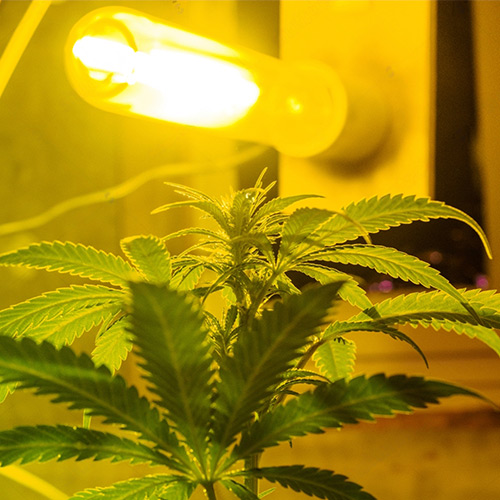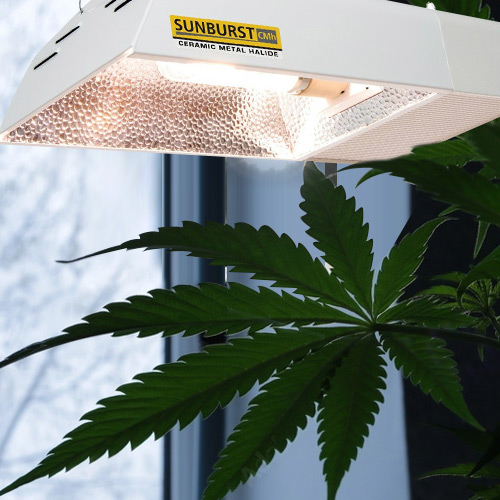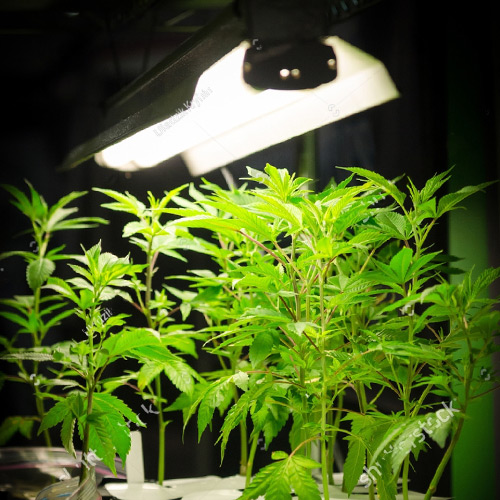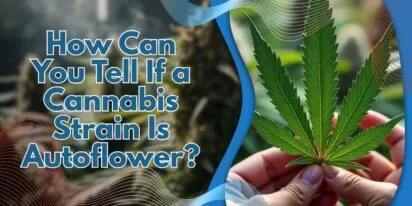Table of Contents

Indoor cannabis cultivation is a craft that relies on precise environmental control. Without natural sunlight, choosing cannabis grow lights becomes paramount to ensure optimal plant development and bountiful yields. Let’s delve into indoor cannabis cultivation and explore how the right grow lights can make all the difference.

Indoor cannabis growers without access to natural sunlight must rely on grow lights to cultivate their plants effectively. These artificial grow lights serve as a substitute for the sun and facilitate the growth of plants and their buds. As light is essential to the plant’s development, without sufficient illumination, even a thriving cannabis plant will yield minimal buds.

When it comes to cannabis grow lights, there are three primary categories to consider, each with its own advantages and disadvantages.
HID lights are the most common grow lights used for marijuana cultivation. They produce a lot of light and heat, which can benefit plant growth, but they also require proper ventilation and cooling to prevent plant damage. The two types of HID lights commonly used for marijuana cultivation are Metal Halide (MH) and High-Pressure Sodium (HPS) lights.

LED grow lights are becoming increasingly popular for marijuana cultivation due to their energy efficiency, long lifespan, and ability to produce specific light wavelengths that can enhance plant growth. They produce less heat than HID lights, which can benefit indoor cultivation where temperature control is important.

Fluorescent lights are another type of grow light used for marijuana cultivation but are less commonly used than HID and LED lights. They are less intense than HID and LED lights but are more energy-efficient and can be used for smaller grows or as supplemental lighting. The two types of fluorescent lights commonly used for marijuana cultivation are T5 and CFL (Compact Fluorescent Light) bulbs.


HID grow lights are significantly more efficient and utilize bulky, peculiarly shaped bulbs. Typically, these bulbs are affixed to a reflector or hood to reflect and concentrate the emitted light onto the plants. While HID lights are highly effective at promoting cannabis growth, they tend to generate substantial heat and require an exhaust system to dissipate the excess warmth.

Metal Halide grow lights are utilized during the vegetative stage of growth since they emit a bluish light that is particularly favorable to vegetative plants. However, these lights can also be used throughout the entire growth cycle, including the harvest stage.

During the flowering stage of cannabis growth, High-Pressure Sodium (HPS) grow lights are frequently utilized due to their high efficiency and ability to stimulate bud production with their yellow light spectrum. These lights are currently the most efficient grow lights available to yield more buds per watt of electricity consumed, which is a major reason for their widespread popularity.

It’s important to note that “LEC” and “CMH” are interchangeable terms used to describe the same type of grow light: Ceramic Metal Halide. These bulbs are classified as High-Intensity Discharge (HID) lights and employ ceramic components similar to those used in High-Pressure Sodium (HPS) bulbs, resulting in higher efficiency than regular Metal Halide (MH) lights, although still not quite as efficient as HPS bulbs.
Pros:
HID grow lights are highly efficient and provide the highest yields per watt of any grow light.
HPS grow lights, in particular, are the most efficient type of HID light and are best for the flowering stage of cannabis growth. With HPS grow lights during the flowering stage, you can expect around 0.5-1 gram of yield per watt if properly used.
HID lights are easy to use, can be hung appropriately from the plants without any guesswork (unlike LEDs), and don’t require constant adjustments (like fluorescents).
Cons:
HID bulbs produce a significant amount of heat, which can be concentrated and intense. To prevent excessive heat and heat-related damage to plants, a hood is usually required, and some form of cooling is needed, especially for bulbs with power above 250W.
Setting up an exhaust fan with ducting to vent out the heat generated by HID lighting can be challenging and discouraging for some growers.
HID lighting requires more parts than other lighting types. Unlike fluorescents, which only require a bulb and fixture, or most LEDs, which are just the light itself, HID setups include a bulb, fixture, external ballast, and an additional cable (not including the exhaust system parts).

LED grow lights have gained significant popularity among cannabis cultivators as a substitute for HPS grow lights. One of their primary advantages is that they tend to operate at cooler temperatures and frequently have integrated cooling systems. Additionally, they can be conveniently plugged into a wall and hung over plants, making them more user-friendly than HID grow lights. Due to their superior penetration capabilities, LEDs do not need to be moved frequently like fluorescents.
Pros:
Unlike HID bulbs, LED grow lights have built-in cooling systems that prevent heat from contaminating plants.
Smaller LED lights can be plugged directly into the wall and hung up over plants without additional setup.
Some growers report that LED lights produce more resinous buds than other types of lights when used alone or combined with HPS grow lights.
Cons:
Although LED lights produce less heat than HPS bulbs, larger models may still need to be vented with an exhaust fan to prevent overheating.
LEDs generally yield slightly less per watt than HPS grow lights, but results can vary depending on the specific lamp and grower experience.
LED lights require more space between the lamp and plants than other lights, which can be challenging in smaller grow spaces.

Various types of fluorescent grow lights are available in different shapes and sizes, ranging from twisty bulbs to elongated tubes. Fluorescents are well-liked as they offer efficient and pleasant lighting for human use while consuming less electricity, making them a great choice for low-key indoor gardening, such as herb gardens.

CFL grow lights are compact fluorescent bulbs easily found in stores where traditional light bulbs are sold. These bulbs emit a suitable spectrum of light for growing cannabis and are versatile enough to fit into small spaces like a cabinet. Keeping the CFLs close to the plants is recommended to achieve the best yields and growth.

T5 grow lights are among the most commonly found types of grow lights that are utilized to grow a wide variety of plants. Therefore, they are typically available at various home improvement and garden stores. T5 lights are significantly broader than CFLs and generally come in a panel format. However, they can still be positioned just a few inches away from plants without the risk of causing any damage or burning them.
Pros:
They are affordable.
Fluorescents consume minimal electricity and generate low heat, especially when not overcrowded in small areas.
Fluorescents provide an ideal light spectrum for growing cannabis.
They can be kept in close proximity to plants, making them ideal for short spaces.
Fluorescent lights are among the best options for clones, seedlings, and young plants. Using larger lights on young plants risks burning them and wastes energy. Fluorescents can save money on electricity during the first few weeks of growth compared to high-powered grow lights.
Cons:
Fluorescents produce smaller yields per watt than other grow light types when used during the flowering stage when buds are forming. Typically, using fluorescents, you can expect around 0.25 grams of buds per watt of electricity (based on actual watts drawn from the wall, not equivalent watts), while LEDs and HPS lights can provide 2-4 times as much yield per watt.
The light emitted by fluorescent lamps does not penetrate deep into the plant, so they are more suitable for plants trained to grow short and flat. They are not powerful enough to support the growth of tall plants during the flowering stage.
In conclusion, choosing the right grow lights for your indoor cannabis cultivation is essential for success. Each type of grow light has its unique benefits and drawbacks, and the choice ultimately depends on your specific needs, space, and budget. With the right lighting setup, you can maximize the potential of your indoor cannabis garden and enjoy a bountiful harvest.

Curious about growing weed in a healthy, effective way? Welcome to the realm of weed hydro! This method uses water instead of soil, delivering n

Peyote Zkittlez is a unique cannabis strain that has quickly gained dedicated followers among enthusiasts and patients alike. Its parentage—Zk

As growers, we want strains that work well, are strong, and are of good quality. Autoflowering cannabis strains are a big step forward for both

Pot growers always ask the same basic question: How much weed does a weed plant produce? The answer is complex and depends on a multitude of var

Ever had the room spin after a few hits? You're not alone. Figuring out how to prevent getting dizzy high can make your cannabis experience a wh

Drying cannabis properly is a critical process in preserving the plant's full aroma and flavor and its psychoactive abilities. Tampering with th

Ever caught yourself a bit too high and all of a sudden in need of being normal? Whether you're heading out for munchies or bumping into someone

Looking for sage advice on how not to get pinched with weed without batting an eye? Attempting to protect your stash from gossipy roommates, sno

Nutrient lockout, also known as nutrient binding or chemical antagonism, is a significant issue in cannabis cultivation that negatively impacts

Germination is the most critical initial stage in growing healthy, high-quality cannabis plants. During germination, the dormant seed becomes a
Are You 18 Or Over?
By selecting “Continue”, you confirm that you are at least 18 years of age and legally permitted to access cannabis related content in your region.
By using Rocketseeds.com, you agree to our legal disclaimer.
Excellent blog here Also your website loads up very fast What web host are you using Can I get your affiliate link to your host I wish my web site loaded up as quickly as yours lol
Your writing is not only informative but also incredibly inspiring. You have a knack for sparking curiosity and encouraging critical thinking. Thank you for being such a positive influence!
Simply wish to say your article is as amazing The clearness in your post is just nice and i could assume youre an expert on this subject Well with your permission let me to grab your feed to keep updated with forthcoming post Thanks a million and please carry on the gratifying work
Somebody essentially lend a hand to make significantly articles Id state That is the very first time I frequented your website page and up to now I surprised with the research you made to make this actual submit amazing Wonderful task
Your blog is a beacon of light in the often murky waters of online content. Your thoughtful analysis and insightful commentary never fail to leave a lasting impression. Keep up the amazing work!
Thank you for the auspicious writeup It in fact was a amusement account it Look advanced to more added agreeable from you By the way how could we communicate
Your blog is a constant source of inspiration for me. Your passion for your subject matter shines through in every post, and it’s clear that you genuinely care about making a positive impact on your readers.
Your blog is a constant source of inspiration for me. Your passion for your subject matter is palpable, and it’s clear that you pour your heart and soul into every post. Keep up the incredible work!
Your articles never fail to captivate me. Each one is a testament to your expertise and dedication to your craft. Thank you for sharing your wisdom with the world.
Your blog is a testament to your dedication to your craft. Your commitment to excellence is evident in every aspect of your writing. Thank you for being such a positive influence in the online community.
Your writing has a way of resonating with me on a deep level. I appreciate the honesty and authenticity you bring to every post. Thank you for sharing your journey with us.
Your blog is a true gem in the world of online content. I’m continually impressed by the depth of your research and the clarity of your writing. Thank you for sharing your wisdom with us.
Hi i think that i saw you visited my web site thus i came to Return the favore Im attempting to find things to enhance my siteI suppose its ok to use a few of your ideas
Somebody essentially help to make significantly articles Id state This is the first time I frequented your web page and up to now I surprised with the research you made to make this actual post incredible Fantastic job
Usually I do not read article on blogs however I would like to say that this writeup very compelled me to take a look at and do so Your writing taste has been amazed me Thanks quite nice post
Your blog has quickly become one of my favorites. Your writing is both insightful and thought-provoking, and I always come away from your posts feeling inspired. Keep up the phenomenal work!
Every time I visit your website, I’m greeted with thought-provoking content and impeccable writing. You truly have a gift for articulating complex ideas in a clear and engaging manner.
Hey there You have done a fantastic job I will certainly digg it and personally recommend to my friends Im confident theyll be benefited from this site
I have read some excellent stuff here Definitely value bookmarking for revisiting I wonder how much effort you put to make the sort of excellent informative website
Nice blog here Also your site loads up very fast What host are you using Can I get your affiliate link to your host I wish my site loaded up as quickly as yours lol
What i do not understood is in truth how you are not actually a lot more smartlyliked than you may be now You are very intelligent You realize therefore significantly in the case of this topic produced me individually imagine it from numerous numerous angles Its like men and women dont seem to be fascinated until it is one thing to do with Woman gaga Your own stuffs nice All the time care for it up
Your blog is a beacon of light in the often murky waters of online content. Your thoughtful analysis and insightful commentary never fail to leave a lasting impression. Keep up the amazing work!
Your blog is a breath of fresh air in the often stagnant world of online content. Your thoughtful analysis and insightful commentary never fail to leave a lasting impression. Thank you for sharing your wisdom with us.
Your blog is a beacon of light in the often murky waters of online content. Your thoughtful analysis and insightful commentary never fail to leave a lasting impression. Keep up the amazing work!
Usually I do not read article on blogs however I would like to say that this writeup very compelled me to take a look at and do it Your writing style has been amazed me Thank you very nice article
Your writing has a way of resonating with me on a deep level. I appreciate the honesty and authenticity you bring to every post. Thank you for sharing your journey with us.
This hydroponics guide is quite the buzz, seriously! Who knew growing weed without dirt could be so complicated yet potentially rewarding? The breakdown of systems like DWC and NFT is helpful, though I suspect my cat might confuse the air pump for a toy. The idea of cleaner buds is tempting, especially since explaining hydro weed to my non-growing friends might get messy. And the bit about potential dizziness from hydro weed? Perfect, now I have an excuse for why I always stumble a bit after a grow session. Still, the promise of faster grows and higher yields is hard to ignore, even if it means more trips to the pH meter than to the coffee shop. Overall, a cultivating read for the curious grower!